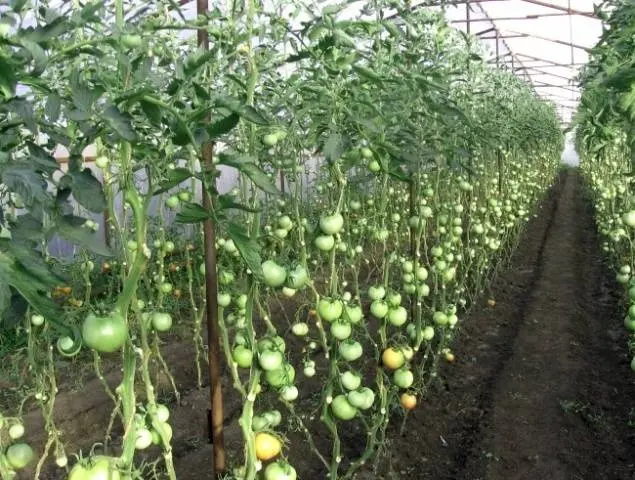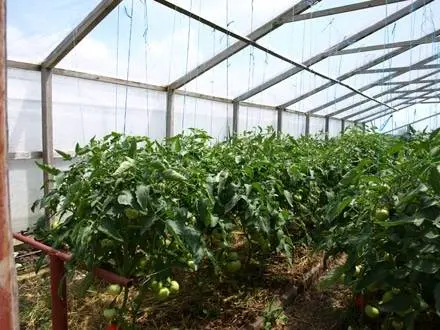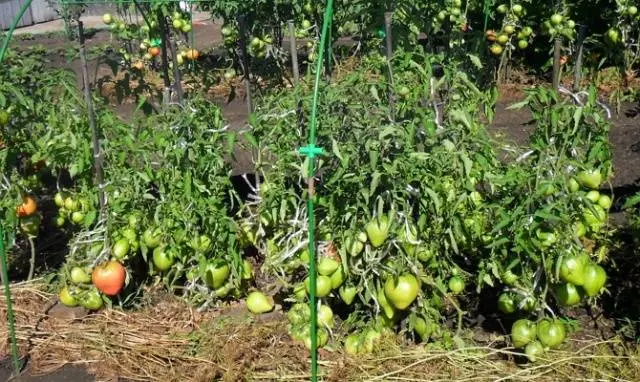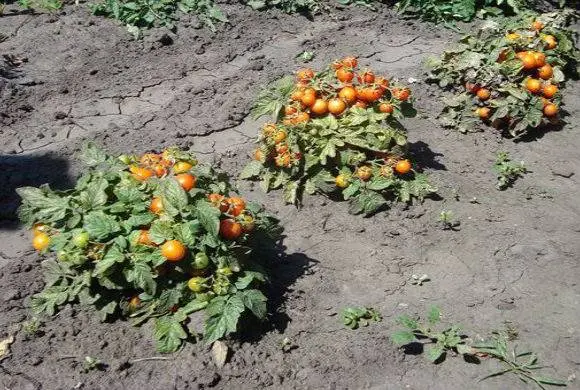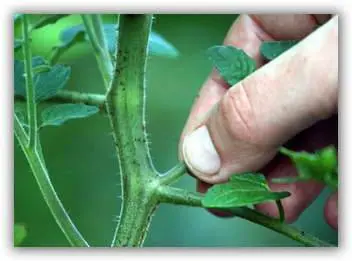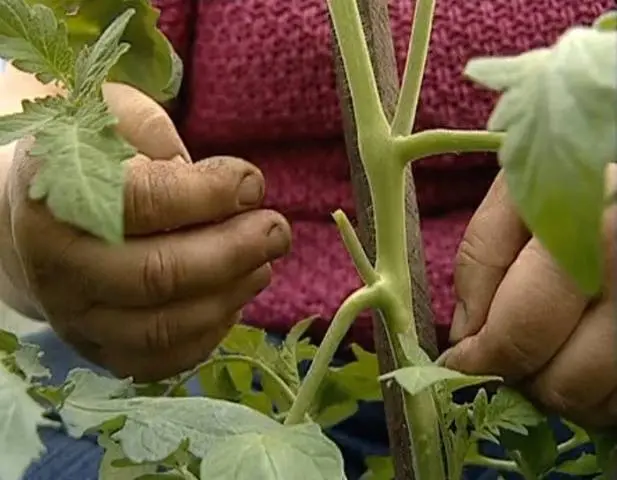Contents
Tomatoes are plants from the nightshade family. Their homeland is South America. Shitomatl, as the Indians called it, is still found there in the wild. The weight of such a tomato is only 1 g. Like any other plant, the main goal of a tomato is to continue the genus, i.e., flowering and fruiting. For this, the bushes must be strong and accumulate a lot of green mass. There may be few fruits. For centuries, breeders have been working to ensure that tomatoes give a big harvest, and not increase the leaf apparatus. But changing the nature of a plant is not easy. So stepchildren grow tomatoes, and gardeners tirelessly form plants, setting it up to harvest.
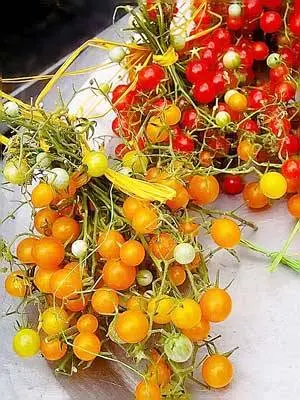
Pictured is a wild tomato crop.
If you do not carry out pinching and let the tomatoes grow as they please, then you get continuous thickets, in which it is not easy to find tomatoes. So, wild tomatoes grow in their homeland. Climatic conditions allow them to give a good harvest even in the absence of care and formation. But the size of their fruits is tiny. They are more like currants. Yes, and disease resistance in wild tomatoes is laid down at the genetic level. Cultivars without proper care and pinching will inevitably fall ill with late blight, and then the harvest can no longer be expected.
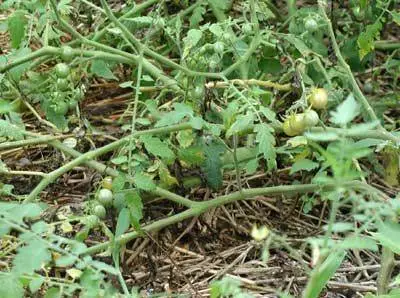
There are many varieties of tomato. Each gardener grows his favorite and repeatedly tested. Care for different groups of varieties is different, as is the formation.
Characteristics of tomatoes
According to the strength of growth, tomatoes are divided into tall, medium and short.
According to the type of growth, the following groups of tomatoes can be distinguished:
- Indeterminate – their growth is not limited, they grow and form flower brushes one by one, as long as weather conditions allow. The first flower cluster can be seen above the 7th-9th leaf. The next – every 2 or 3 sheets. Ripening time is usually medium or late.

- Semi-determinant. This is an intermediate type between indeterminate and determinant varieties. Brushes on the main stem – up to 10. They form many stepchildren. Most often they are planted in a greenhouse.

- Determinate – can form a certain number of brushes, as a rule, from 5 to 7 on the main stem, further growth of the central shoot ends and the rest of the crop is already formed on stepchildren, which also limit growth. Flower brush starts from the seventh sheet and then through 1 or 2 sheets. Maturity can be any.

- Superdeterminant and standard varieties are the most compact. There are no more than 3 brushes on the main stem, its growth ends quickly, the number of stepchildren is limited. Flower brushes are laid very early, sometimes already after 4 leaves. These varieties are distinguished by a strong stem, they are low and usually do not produce large fruits. In terms of maturation, they are early-ripening and ultra-early.

Such tomatoes are more hardy and resist diseases well.
The only exceptions are the southern regions, where, with an appropriate garter, indeterminate tomatoes are also successfully grown in open ground.
The method of formation depends on the type of tomato growth and consists of several operations:
- tomatoes stepchildren;
- the bush is clarified, that is, the leaves are cut off in a certain order;
- pinching of shoots is carried out.
Stepchildren and stepchildren
Stepchildren grow in the axil of a tomato leaf and are its generative organ.

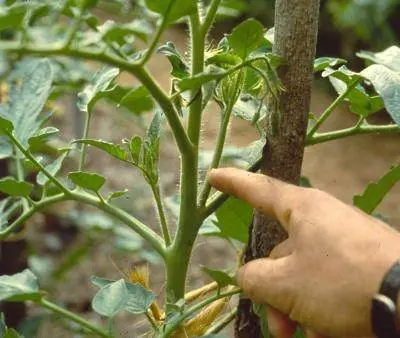
Stepson needs food. If they do not plan to leave it to form a crop, removal must be carried out without fail and in a timely manner. When is the best time to remove stepchildren? The best time is when their size is not less than 4 cm and not more than 6 cm.
Why not delete sooner or later? With an earlier removal, it will not be possible to leave a stump of about 3 cm. It is needed in order to prevent the growth of a new stepson from this sinus. With a later removal, the bush is weakened, since the growth of the unnecessary part consumes the nutrition necessary for the formation of fruits. The plant is under stress.
Stepchildren rules
- Remove stepchildren in the morning so that the wounds have time to dry before evening.
- Break them off with your hands without touching the injured part of the tomato, so as not to infect. Working with scissors, disinfect them by dipping them in a dark solution of potassium permanganate after each removal so as not to transmit a latent infection from tomato to tomato.
- Do not stepchild a few days before and after the full moon. On the growing moon, the aerial part of the plant is most saturated with juices. The loss of even a small part of the plant will be difficult for the tomato and will take a lot of strength.
- Do not handle tomatoes after handling potato plants. So, it is very easy to infect tomatoes with late blight.

- After removal, a stump must necessarily remain, preventing the growth of a new stepson from the sinus.

- Stepchildren regularly, as stepchildren grow very quickly.
The plant must be absolutely dry, otherwise phytophthora cannot be avoided.
How to lighten tomato bushes
The rules for removing extra leaves are the same as for pinching. The timing will tell the full formation of the brush and the first signs of its ripeness.
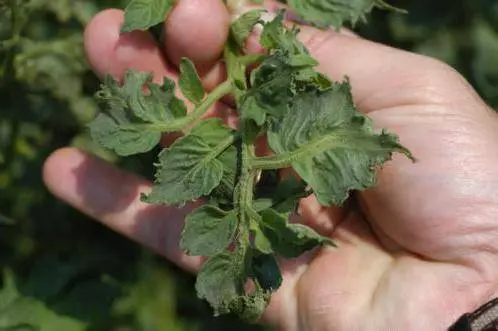
Tomatoes after removing the leaves.
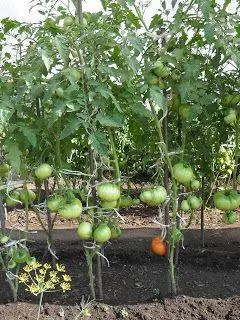
Pinch shoots
This event is necessary to remove brushes that do not have time to mature. When pinching plants, leave 2 leaves above each brush. The rules for working with tomatoes are the same as for pinching.
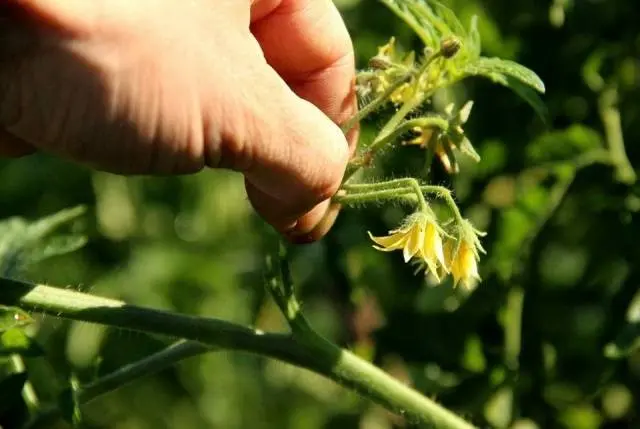
Formation of tomatoes in open ground
What determines the method of forming low-growing tomatoes in open ground? There are several factors here.
- type of tomato growth.
- Tomato variety.
- Growing conditions: care, soil fertility.
- Weather.
Peculiarities of pinching different types of tomatoes
The choice of the type of tomatoes depends on how quickly the gardener wants to get ripe fruits and what kind of crop he expects. All standard varieties are characterized by precocity, they give an early harvest, but since the bush itself does not grow long, this early harvest quickly ends.
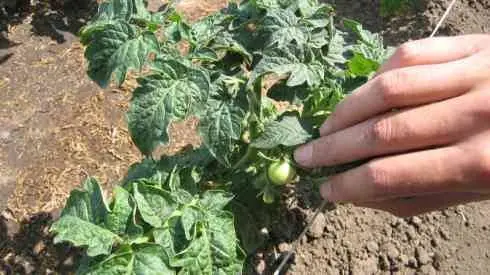
But then the seedlings will have to grow more.
Standard varieties
The formation of a standard bush is carried out only when there is a desire to try tomatoes very early. In all other cases, these tomatoes do not need to be formed.
Gain in terms of maturation can be up to 14 days.
Superdeterminants
Superdeterminant tomatoes are grown without pinching, but they will have to be tied up. The maximum that can be done with them is to remove a pair of lower stepsons, if any. Remove a few lower leaves as well.
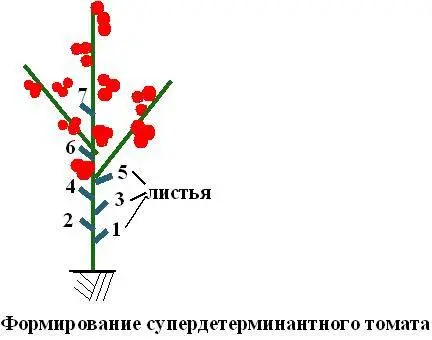
determinants
For determinants, the formation is carried out depending on the variety, the strength of the growth of the bush, and even on whether it will be warm and sunny in summer. There are many undersized varieties bred by breeders for lazy or very busy gardeners, they do not need pinching.
One can name a whole series of non-step-child varieties of the Ural selection: non-step-son scarlet, pink, rounded, raspberry, plum-shaped, cylindrical, amber. All these tomatoes are short and early. The varieties Vzryv, Danko, Monetary, Siberian trump card, Parsley-gardener, Watercolor, Supermodel, Eldorado, Skorospelka, Golden stream are not stepson either.
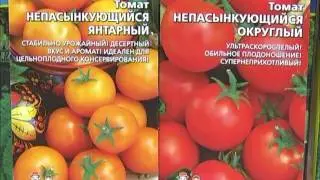
Carefully read everything that is written on the package when choosing a tomato variety.
Yet most determinant varieties need shaping. There are two main ways of growing determinants: in 1 and in 2 stems. In the first method, one main stem is left on the tomato, removing all stepchildren. With the second method, the crop will be formed on the central shoot and on one stepson, it should be located directly under the lower flower brush.
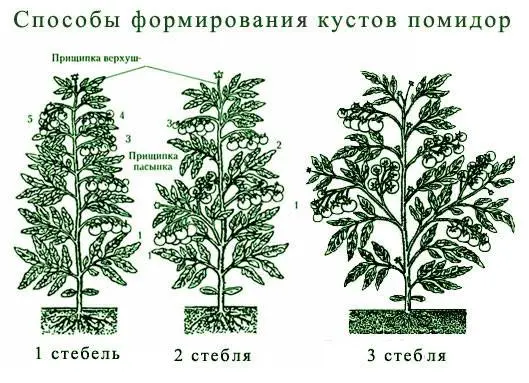
They are distinguished by great growth force and take away a lot of nutrition from the plant, slowing down the formation and maturation of the crop.
All brushes are left on the central shoot, and only two on the stepson. It needs to be pinched 2 sheets after the second brush.
There is another way to pinch low-growing tomatoes for open ground. The central stem is pinched when 3 brushes are formed, leaving 2 leaves; first. This method is called – in one escape with a continuation. Here are more ways to form determinants.
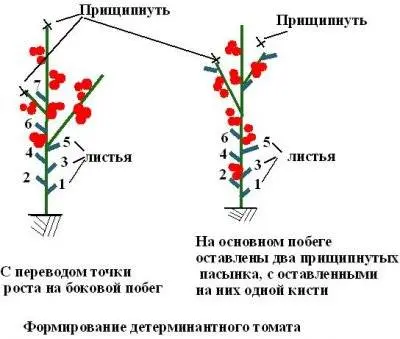
There are exceptions to every rule. Provided that the soil is fertile enough, the care is carried out according to all the rules, and the summer pleases with warm and sunny days, you can leave additional stepchildren on the tomato.
The meaning of pinching is not only to ration the crop in accordance with the capabilities of the tomato, but also to create the best conditions for the rapid ripening of fruits. And this is possible only with their least shading.
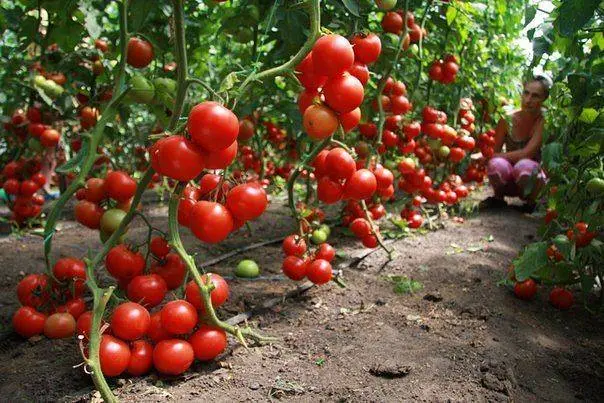
For the same purpose, another agrotechnical technique is carried out, which is part of the process of plant formation: breaking off leaves on a tomato. It begins only when the lower brush is fully formed and the fruits begin to sing.
This procedure gives a double win – the tomatoes on the lower brush are more illuminated by the sun and ripen faster, and the bush is better ventilated, which reduces the likelihood of phytophthora, because there is no contact between the leaves and the soil.
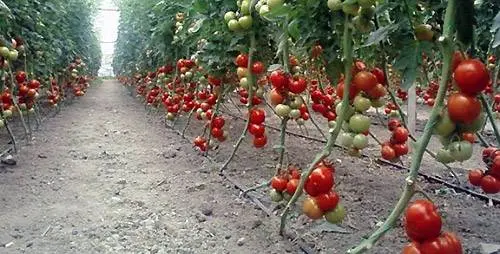
The last operation that is carried out to form tomato plants is pinching the tops. They do it in the third decade of July, cutting off all the extra brushes that no longer have time to bear fruit, but will slow down the ripening of the rest of the crop.
The video shows how a professional tomato grower forms tomatoes:
Formation of undersized varieties in the greenhouse
Low-growing tomatoes are quite good for the greenhouse. The determinants will give an excellent harvest in it, since their development takes longer. Of course, the yield of determinant varieties cannot be compared with that of indetes, but there is much less trouble with them.
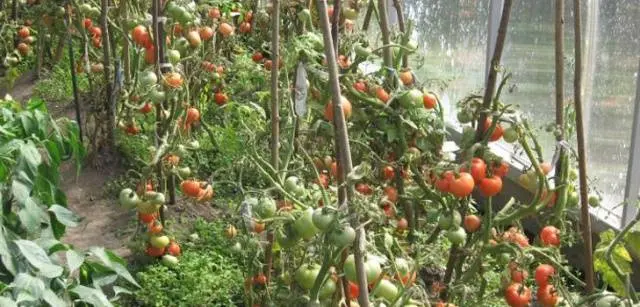
The formation of low-growing tomatoes in the greenhouse is no more difficult than that of determinant varieties in the open field and is not much different. Unless you can leave more flower brushes, they will all have time to form fruits and give a harvest. Some gardeners, in general, do without pinching a tomato in a greenhouse, but even if the tomato does not pinch, it is still necessary to lighten the bushes, since late blight does not doze.
Valery Medvedev will tell about how to form determinant varieties in a greenhouse in the video:
Properly formed tomatoes, taking into account the variety, type of growth and growing conditions, will give a good harvest in any summer.











